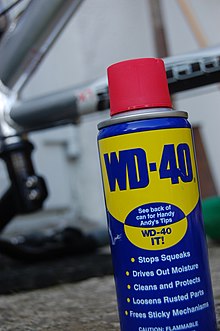WD-40: Difference between revisions
m Reverted 3 edits by 121.210.196.131 to last version by Bucklesman |
→Typical uses of WD-40 around the home include:: if it doesn't work, it's not a "typical use" |
||
| Line 33: | Line 33: | ||
* Spraying on hand tools prior to storage to protect against rust |
* Spraying on hand tools prior to storage to protect against rust |
||
* Cleaning objects affected by grease, caked-on dirt or adhesive residue (such as that left behind by [[sticky tape]]) |
* Cleaning objects affected by grease, caked-on dirt or adhesive residue (such as that left behind by [[sticky tape]]) |
||
* Contrary to reports WD 40 is ineffective for cleaning glass shower screens. |
|||
====Typical use of WD-40 in automotive repair include:==== |
====Typical use of WD-40 in automotive repair include:==== |
||
Revision as of 01:31, 21 October 2007


WD-40 is the trademark of a widely used penetrating oil (cleaner, lubricant and anti-corrosive solution) spray. It was developed in 1953 by Norm Larsen (then working for the Rocket Chemical Company) to eliminate water and prevent corrosion on electrical circuitry. It also has many household uses.
WD-40 stands for "Water Displacement, 40th attempt", a name which came from Larsen's laboratory notebook. Larsen was attempting to concoct a formula to prevent corrosion by displacing water, and arrived at the formula on his 40th attempt.[1] A common myth is that "WD" stands for "war department".
WD-40 was first used by Convair to protect the outer skin of the Atlas missile from rust and corrosion. The product first became commercially available on store shelves in San Diego in 1958.
Formulation
Main ingredients, from the material safety data sheet, are:
- 50%: Stoddard solvent (mineral spirits, also commonly known as dry cleaning solvent)
- 25%: Liquefied petroleum gas (presumably as a propellant, carbon dioxide is used now to reduce considerable flammability)
- 15+%: Mineral oil (light lubricating oil)
- 10-%: Inert ingredients
The German version of the mandatory EU safety sheet lists the following safety relevant ingredients:
- 60-80%: Heavy Naphtha (petroleum product), hydrogen treated
- 1-5%: Carbon dioxide
It further lists flammability and effects to the human skin when repeatedly exposed to WD-40 as risks when using WD-40. Nitrile gloves and safety glasses should be used. Water is unsuitable for extinguishing burning WD-40.
There is a popular urban legend that the main ingredient in WD-40 is fish oil. Although it is unknown whether the formula contains fish oil, material safety data sheets for the product show that the main ingredient is Stoddard solvent, not fish oil.[2] WD-40 is, however, used by some sea fishermen as an added scent when fishing with bait.
Uses
Typical uses of WD-40 around the home include:
- Stopping squeaks in door hinges and generally freeing up simple mechanical items found around the house, such as door locks
- Loosening rusting components, such as nuts and screws, so they can be removed
- Spraying on hand tools prior to storage to protect against rust
- Cleaning objects affected by grease, caked-on dirt or adhesive residue (such as that left behind by sticky tape)
Typical use of WD-40 in automotive repair include:
- Driving moisture out of the high and low tension electrical components of a motor engine, so that it can start (particularly on cold days). E.g. cleaning and drying the inside of the cap of the ignition distributor.
- Loosening nuts and screws
- Cleaning car locks
- Cleaning wheels
- The WD-40 company claims it is safe for use on all motorcycle chains, but recommended cleaning products vary among chain manufacturers. Tsubaki Chain[3] and RK Chain recommend WD-40 to clean or displace water on all types of chains, including sealed ring.[4]
Specialty Uses:
- Leatherman, the manufacturer of the popular multi-tool of the same name, recommends WD-40 as a post-cleaning lubricant to displace water and prevent corrosion.[5]
- WD-40 dissolves cocaine.[6]
- In Boston, officials repaired the bell atop city-owned Faneuil Hall with daily treatments of WD-40 over the course of a week.[7]
Competitors
WD-40's success has spawned a number of competitors in different countries. In Australia, WD-40 is in direct competition with Selleys RP7. At one time there was for sale in Mexico a similar product called "WB-50," whose name apparently had no meaning other than to market it as an alternative to WD-40.[citation needed] GT85 is also common in the United Kingdom. In Germany the common brand is "Caramba." "Kontakt 40" and CRC 5.56 are other similar products.
WD-40 Company
In 1969, the Rocket Chemical Company renamed itself WD-40 after what was then its only product, but WD-40 was still sold as "Rocket WD-40" for many years, with the history of its use in preserving Atlas rockets printed on each can. The company went public in 1973. Its NASDAQ stock symbol is (Nasdaq: WDFC). In recent years the WD-40 company has acquired several household-products companies, adding such brand names as 3-In-One Oil, Lava, Spot Shot, X/14, Carpet Fresh and 2000 Flushes to its roster. The company still has its corporate offices in San Diego, California.[8] It now markets its products in more than 160 countries around the world. In 2003, it recorded sales of $238.1 million.
References
- ^ http://www.wd40.com/AboutUs/our_history.html
- ^ http://www.wd40.com/Brands/pdfs/msds-wd40_aerosol.us.pdf
- ^ http://www.tsubaki-rider.com/?type=maintenance
- ^ http://www.ftmbiz.com/faq.html
- ^ http://www.leatherman.com/products/tool-maintenance/default.asp
- ^ http://news.bbc.co.uk/1/hi/magazine/4566526.stm
- ^ http://www.boston.com/news/local/massachusetts/articles/2007/05/04/it_tolls_for_the_city/
- ^ Killion, Andy (2007-04-09). "Revenue, Net Income Both Rise at WD-40". San Diego Business Journal. Retrieved 2007-04-13.
{{cite news}}: Check date values in:|date=(help); External link in|publisher=
